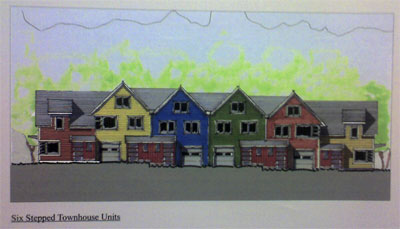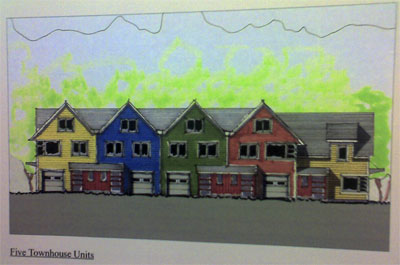[Scott] argues that centrally managed social plans derail when they impose schematic visions that do violence to complex interdependencies that are not–and cannot be–fully understood. Further, the success of designs for social organization depends on the recognition that local, practical knowledge is as important as formal, epistemic knowledge.
The author builds a persuasive case against “development theory” and imperialistic state planning that disregards the values, desires, and objections of its subjects. And in discussing these planning disasters, he identifies four conditions common to them all: the state’s attempt to impost administrative order on nature and society; a high-modernist ideology that believes scientific intervention can improve every aspect of human life; a willingness to use authoritarian state power to effect large-scale innovations; and a prostrate civil society that cannot effectively resist such plans.
While many of the “great state-sponsored calamities” of the last century can be attributed to rulers with grandiose plans, Scott observes that “much of the massive, state-enforced social engineering of the twentieth-century has been the work of progressive, often revolutionary elites. Why?”
The answer, I believe, lies in the fact that it is typically progressives who have come to power with a comprehensive critique of existing society and a popular mandate (at least initially) to transform it. These progressives have wanted to use that power to bring about enormous changes in people’s habits, work, living patterns, moral conduct, and worldview… Where the utopian vision goes wrong is when it is held by ruling elites with no commitment to democracy or civil rights and who are therefore likely to use unbridled state power for its achievement. Where it goes brutally wrong is when the society subjected to such utopian experiments lacks the capacity to mount a determined resistance… (p.89)
One of the great paradoxes of social engineering is that it seems at odds with the experience of modernity generally. Trying to jell a social world, the most striking characteristic of which appears to be flux, seems rather like trying to manage a whirlwind… (p.93)
Scott critiques Brasilia, a super-modern city inspired by the concepts of Le Corbusier. In a desire for order, security and efficiency, the new city fostered “sculptural masses widely separated by large voids… Given our perceptual habits, these voids in the modernist city seem to be not inviting public spaces but boundless, empty spaces that are avoided.” (p.121)
…the built environment affects those who dwell in it. Compared to life in Rio and Sao Paulo, with their color and variety, the daily round in bland, repetitive, austere Brasilia must have resembled life in a sensory deprivation tank…
The anonymity induced by Brasilia is evident from the scale and exterior of the apartments that typically make up each residential superquadra… For superquadra residents, the two most frequent complaints are the sameness of the apartment blocks and the isolation of the residences (“In Brasilia, there is only house and work”). The facade of each block is strictly geometric and egalitarian. Nothing distinguishes the exterior of one apartment from another… Part of the disorientation arises from the fact that apartment dwelling–especially, perhaps, this form of apartment dwelling–fails to accord with deeply embedded conceptions of home. Holston asked a class of nine-year-old chidren, most of whom lived in superquadra, to draw a picture of “home.” Not one drew an apartment building of any kind. All drew, instead, a traditional freestanding house with windows, a central door, and a pitched roof… the design of the residential city militates against individuality… (p.126-127)
Scott quotes Jane Jacobs, a major critic of modernist urban planning, in her support for a more bottom-up approach for cities to let natural order grow from the people’s preferences:
“the public peace–the sidewalk and street peace–of cities…is kept by an intricate, almost unconscious network of voluntary controls and standards among the people themselves, and enforced by the people themselves.” (p.135)
…Diversity, cross-use and complexity (both social and architectural) are Jacobs’s watchwords. The mingling of residences with shopping areas and workplaces makes a neighborhood more interesting, more convenient, and more desirable–qualities that draw foot traffic that in turn make the streets relatively safe… The popularity of a district and its economic success go hand in hand. Once created, such places will attract activities that most planners would have specially sequestered elsewhere. Rather than play in the large parks created for that purpose, many children prefer the sidewalks, which are safer, more eventful, and more convenient to the comforts available in stores and at home… (p.136-137)
From time to time Jacobs stands back from the infinite and changing variety of American cities to express a certain awe and humility: “Their intricate order–a manifestation of the freedom of countless numbers of people to make and carry out countless plans–is in many ways a great wonder. We ought not to be reluctant to make this living collection of interdependent uses, this freedom, this life, more understandable for what it is, nor so unaware that we do not know what it is.” The magisterial assumption behind the doctrines of many urban planners–that they know what people want and how people should spend their time–seems to Jacobs shortsighted and arrogant… (p.140)
Most cities are the outcome…of innumerable small acts bearing no discernable overall intention… [Jacobs praises the unplanned city, saying,] “Cities have the capability of providing something for everybody, only because, and only when, they are created by everybody… The main responsibility of city planning and design should be to develop, insofar as public policy and action can do so, cities that are congenial places for this great range of unofficial plans, ideas and opportunities to flourish.”
…A city that was extensively planned would inevitably diminish much of the diversity that is the hallmark of great towns. The best a planner can hope for is to modestly enhance rather than impede the development of urban complexity. (p.142-143)
…Jacobs quotes with approval Stanley Tankel… “We will have to admit that it is beyond the scope of anyone’s imagination to create a community. We must learn to cherish the communities we have, they are hard to come by.”
…[T]here is little doubt that [Jacobs] has put her finger on the central flaws of hubris in high-modernist urban planning. The first flaw is the presumption that planners can safely make most of the predictions about the future that their schemes require… Second, thanks in part to Jacobs, we now know more about what constitutes a satisfactory neighborhood for the people who live in it, but we still know precious little about how such communities can be fostered and maintained. Working from formulas about density, green space, and transportation may produce narrowly efficient outcomes, but it is unlikely to result in a desirable place to live. Brasilia and Chandigarh, at a minimum, demonstrate this. (p.144-145)
Cities tend to be complex organisms, Scott observes, so planners are constantly tempted to try to simplify their task:
Once the desire for comprehensive urban planning is established, the logic of uniformity and regimentation is well-nigh inexorable. Cost effectiveness contributes to this tendency… [E]very concession to diversity is likely to entail a corresponding increase in administrative time and budgetary cost… (p.141-142)
In Northampton, the simplification du jour appears to be a drive to segregate our open space to the periphery, while weakening greenspace preservation in the more urban districts where it is already scarce.
Scott proposes guidelines to reduce the potential harm from plans. These include:
Take small steps. In an experimental approach to social change, presume that we cannot know the consequences of our interventions in advance. Given this postulate of ignorance, prefer wherever possible to take a small step, stand back, observe, and then plan the next small move…
Favor reversibility. Prefer interventions that can easily be undone if they turn out to be mistakes. Irreversible interventions have irreversible consequences. Interventions into ecosystems require particular care in this respect, given our great ignorance about how they interact…
Plan on surprises. Choose plans that allow the largest accommodation to the unforeseen… In planning housing, it would mean “designing in” flexibility for accommodating changes in family structures or living styles…
Plan on human inventiveness. Always plan under the assumption that those who become involved in the project later will have or will develop the experience and insight to improve on the design… (p.345)
Scott concludes by calling for a healthy respect for diverse lifestyles and the wisdom of ordinary people. In the case of Northampton, we urge planners to respect the preferences of families with children, as this has been a major issue in other Smart Growth cities like Portland.
The power and precision of high-modernist schemes depended not only on bracketing contingency but also on standardizing the subjects of development…
This subject was singularly abstract… Standardized citizens were uniform in their needs and even interchangeable. What is striking, of course, is that such subjects–like the “unmarked citizens” of liberal theory–have, for the purposes of the planning exercise, no gender, no tastes, no history, no values, no opinions or original ideas, no traditions, and no distinctive personalities to contribute to the enterprise…
To the degree that subjects can be treated as standardized units, the power of resolution in the planning exercise is enhanced. Questions posed within these strict confines can have definitive, quantitative answers…
What is perhaps most striking about high-modernist schemes, despite their quite genuine egalitarian and often socialist impulses, is how little confidence they repose in the skills, intelligence, and experience of ordinary people.
…the high-modernist urban complex represents an impoverished and unsustainable social system…
Complex, diverse, animated environments contribute, as Jacobs saw, to producing a resilient, flexible, adept population that has more experience in confronting novel challenges and taking initiative. Narrow, planned environments, by contrast, foster a less skilled, less innovative, less resourceful population. (p.345-349)
…[Our institutions should respect the] social magnetism of autonomy and diversity as seen, for example, in the popularity of Jacobs’s mixed-use neighborhoods and in the continued attraction of self-employment. (p.353)
See also:
Rutherford Platt in Gazette: “The ‘humane micropolis'” (9/6/08)
Northampton is in fact much better than a garden city precisely because
it is not a planned community. Unlike garden cities and other “ideal
communities,” it was not designed as a set piece with its land use and
architecture governed by a unified plan and authority. In fact,
Northampton was never designed at all and that is one reason for its
enduring vitality…
Urban adaptation cannot be imposed from
above through preconceived plans. Instead, it depends upon the
resourcefulness of local citizens and their leaders in responding to
challenges and opportunities posed by such factors as physical site
characteristics, regional location, water resources, economics,
technology, culture, and the web of public laws and policies…
…the
funky pre-zoning neighborhoods in Florence, Bay State, and near
downtown have been little affected by zoning which typically ratifies
the status quo rather than create nonconforming use problems.
Post-zoning subdivisions like the Ryan Road area are more akin to
standard suburbs across the country than to the older parts of
Northampton.
Northampton has mercifully been spared top-down, macro plans in vogue from the Garden City era to Urban Renewal in the 1960s…
Reason.org: “The Human Face of Smart Growth Opposition” (9/13/02)
…skeptics of smart growth share many of the same concerns that its advocates have about future growth and development – traffic congestion, environmental degradation, reduced housing affordability, outdated planning codes that prevent innovative developments, to name a few. The difference is that the smart growth skeptics are not willing to buy into a “grand” solution to these challenges.
And why shouldn’t they be skeptical? After nearly a century of urban planning, the latest solution to the planning mistakes of the past and challenges of today is…you guessed it…more planning. The last major urban planning fad – the nationwide urban renewal efforts of the post-WWII era – was sold with the promise of dramatically reinvigorating cities and improving urban life, but the actual result was the wholesale destruction of vibrant urban neighborhoods and the large-scale stifling of inner city economic opportunity. It is not unreasonable to be wary of the latest planning fad, especially when so much is at stake for our families and communities.
Wall Street Journal Opinion Column: “What Jane Jacobs Really Saw” (5/2/06)
Given urban planners’ almost universal reverence for Jacobs, it is ironic that many have largely ignored or misinterpreted the central lesson of “Death and Life”–that cities are vibrant living systems, not the product of grand, utopian schemes concocted by overzealous planners…
Sadly, many in the Smart Growth and New Urbanism movements cite Jacobs as the inspiration for their efforts to combat so-called “urban sprawl” and make over suburbia with dense, walkable downtowns, mixed-use development, and varied building styles. While Jacobs identified these as organic elements of successful cities, planners have eagerly tried to impose them on cities in formulaic fashion…
Wendell Cox: “METROPOLITAN DENVER AT RISK: How Densification Will Intensify Traffic Congestion, Air Pollution and the Housing Affordability Crisis”
What is in vogue is not always correct…
Planners and architects in the 1950s thought that 20-story public housing projects were the answer — the same projects that are being imploded around the country today…
New York Times: “Vibrant Cities Find One Thing Missing: Children” (3/24/05)
After interviewing 300 parents who had left the city, researchers at Portland State found that high housing costs and a desire for space were the top reasons…
Randal O’Toole: “The Folly of ‘Smart Growth'”
The region’s cities and counties encountered major opposition when they tried to rezone existing neighborhoods to higher densities. One Portland suburb recalled its mayor and two members of its city council from office after they endorsed higher densities over local opposition. To meet their targets, planners turned to rezoning farms and other open spaces as high-density areas. One suburban county rezoned a golf course for 1,100 new housing units and 200,000 square feet of office space. Ten thousand acres of prime farmland inside the urban-growth boundary were also targeted for development.
…despite the shortage of single-family housing, Portland residents have failed to embrace Metro’s high-density developments…
Although the smart growth policies — high-density developments, light-rail transit, limited freeway expansions, traffic calming, and parking limits — are supposed to reduce per capita driving by 10 percent, Metro’s own planners say that they will fail to meet that goal…
Sidebar: “The Fruits of Smart Growth”
…Open space in valuable locations such as people’s backyards, urban parks, and golf courses will be transferred to less valuable locations such as private rural farms that are unavailable for recreation.
Planetizen: “Trouble in Smart Growth’s Nirvana” (6/30/02)
Densification is no more popular in Portland’s neighborhoods than it is in Berkeley, Boulder or Bozeman. As a result, a recent citizen’s initiative sought to limit Metro’s (the land use regulation agency) densification power…
Berkeley, California: Cautions on Infill
Citizen input into long-range planning is excellent—which is why citizens are so astonished when their plans are entirely ignored by the current Planning Division. Developers sometimes work successfully with neighbors to create good and popular developments, but a long list of appeals, lawsuits, and despised large developments indicates a major problem. Staff routinely stonewalls, obfuscates, refuses to respond, and ignores neighborhood concerns. In contradiction to our own ordinances, staff makes no genuine attempt to facilitate cooperation between applicants and neighbors. Instead, propelled by their simplistic “smart growth” philosophy, staff encourages developers to build the largest possible projects over neighborhood objections…
We cannot let planners and developers decide what we will do with our lives. I never hear planners discussing psychological health and cultural values. Planners have a different approach. As one Berkeley planner told me, no matter what they build, eventually those who can or must tolerate the new, worse environment will replace those who can’t. As this happens, resistance to further degradation lessens. But I reject this “race to the bottom.” And with enough time, planners and developers could also train Americans to live like drones in anthills—but why let them?
Gazette Guest Column: “Give residents a role in city issues”
For there to be sustainable citizen invovlement in the future of Northampton, input on issues of consequence to the lives of our residents needs to be both actively solicited and facilitated so that critically important opinions are not coming in a delayed, after-the-fact manner, where the opportunity for true discussion has then been missed.
Gazette Lead Editorial: “A public role in planning”
While the Planning Board’s options are limited statutorily, in our opinion there needs to be a way for the board to garner public opinion earlier in the process and work with developers sooner to address design concerns…
Northampton Redoubt: Urban Ecology, Planting Trees, and the Long-Term View
People in favor of the Kohl subdivision have argued that the North Street area is close to city services and infrastructure plus it’s within walking distance to downtown merchants and Bridge Street School. Since Mr. Kohl owns downtown commercial property it makes sense for him to assist in increasing downtown residential density from an economic development point of view. Proponents reason that if all things were equal, five acres of forest lost to development in-town is better than five acres of forest lost to development in the outlying areas. This seems like a valid view,
but are all things equal?
If we remove all of our in-town forested areas and wetlands they will likely be gone forever or at least a very long time. We would do well for posterity to err on the side of caution. For example the cost estimate to restore part of the downtown historic Mill River channel runs into the millions of dollars. Had the river’s diversion in the 1940s been handled differently, perhaps with a sharper eye towards the future, maybe today we wouldn’t be searching for dollars to make its restoration a reality.
There are other aspects of urban ecology that are important as well and we should examine these closely. For instance urban forests provide habitat for birds and small creatures that consume mosquitoes and other insects. Urban forests help to keep our air cleaner by removing pollutants from the atmosphere. They also reduce the size of urban heat islands thereby lessening our need to run air conditioners and fans which traditionally burn fossil fuels.
Northampton’s Flood and Natural Hazard Mitigation Plan: Wetlands Buffers of 100 Feet Are an Effective Flood Mitigation Strategy and Should Be Consistently Enforced
In general, a core problem for infill in Northampton is to avoid placing large numbers of people and structures in low-lying areas downtown that may be at risk for flooding. As the plan states, “In recent years, heavy rainstorms have caused significant problems in more urbanized areas as increased development inhibits proper drainage and existing or poorly maintained water systems cannot handle increased stormwater runoff.”
Northampton Open Space Plan: “This loss of habitat and natural flood buffering areas is Northampton’s most serious environmental problem”
…Although never as polluted as the section of the river below the Holyoke Dam, the water quality in the Connecticut River in Northampton has improved since 1972, when the federal Clean Water Act was passed… There have also been some improvements in pollution from stormwater runoff. That source, though, remains the most significant threat to water quality. (p.18)
The New Draft Sustainable Northampton Plan: Balancing Compact Growth Against Taxes, Urban Greenspace, Homeowner Preferences
An objective of the Plan is to “implement ideas for maximizing density on small lots”. (p.16) It calls for the City to “consider amending zero lot line single family home to eliminate 30′ side yard setback”. (p.69) It suggests the zoning laws be changed to “encourage single family homes in Urban Residential zoning districts by significantly reducing minimum frontage/lot width, for projects meeting form-based coding”. (p. 71)
These changes have the potential to reduce or eliminate the yards that separate homes from each other and from streets. This loss of greenspace may well entail a loss of privacy, attractiveness, flood protection (through an increase in impervious surfaces), and an increase in the heat island effect, noise and congestion. If fewer trees are shading homes, cooling costs are likely to rise…
The Plan calls for high and medium density housing in downtown and the “more densely developed areas”, 12-65 units per acre. (p.13)
…The best plans will fail if they don’t appeal to the people. A 1993 Fannie Mae poll showed that “86 percent of American households believed that owning a home was better than renting…and 73 percent preferred a single-family detached home with a yard” (cited in J. Terrence Farris, “The Barriers to Using Urban Infill Development to Achieve Smart Growth”, 2001, PDF).
Pictures of Northampton Streets at Various Densities
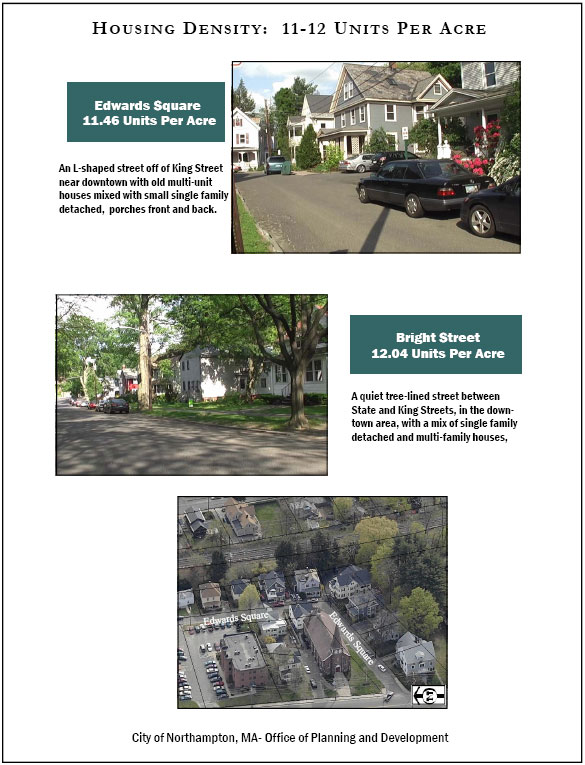
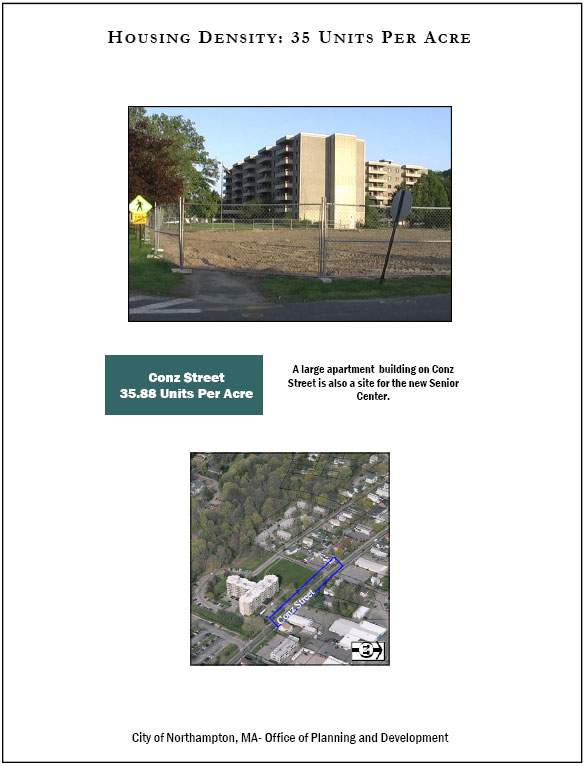
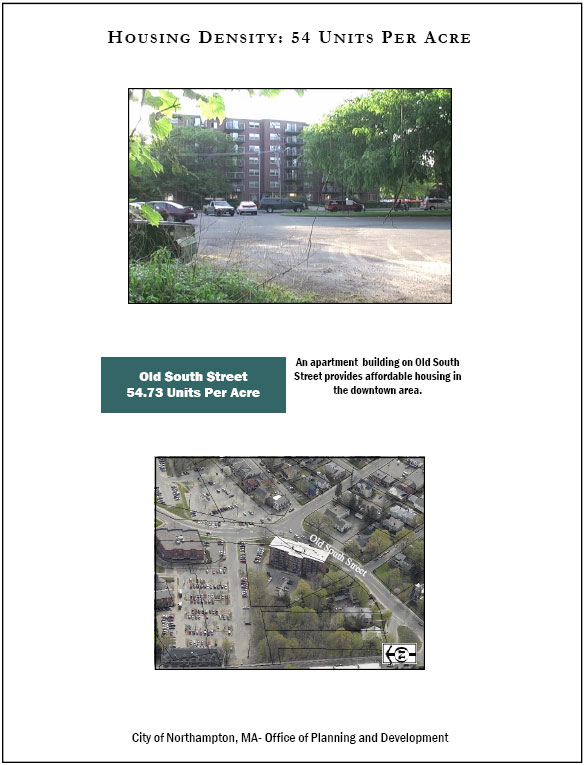
Northampton Redoubt: The Proposed Hilton Garden Inn
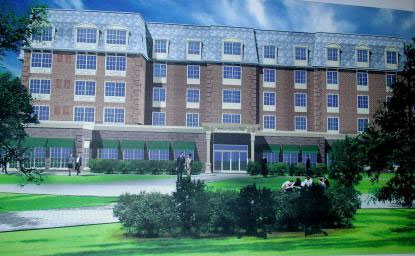
Northampton Redoubt: “Green Street by Ken Mitchell”
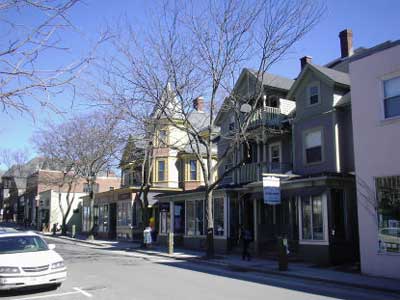
Pictures of Kohl Construction’s Condo Plans
